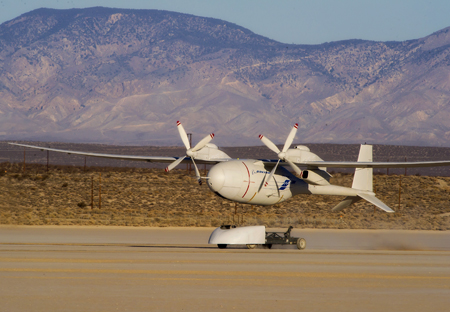Boeing’s  liquid hydrogen-powered Phantom Eye remotely piloted aircraft demonstrator this week completed its second flight, announced company officials. The Phantom Eye climbed above an altitude of 8,000 feet during the Feb. 25 mission at Edwards AFB, Calif., and remained aloft for 66 minutes at a cruising speed of 62 knots before landing, according to the company’s Feb. 26 release. The airplane “exceeded what it achieved” last June during its maiden flight when it flew at an altitude of 4,080 feet and remained aloft for 28 minutes, states the release. And unlike last year’s flight when the Phantom Eye’s landing gear was damaged during landing, the aircraft made “a picture-perfect landing” this time around, said Boeing. “This flight, in a more demanding high-altitude flight envelope, successfully demonstrated Phantom Eye’s maneuverability, endurance, and landing capabilities,” said Drew Mallow, Phantom Eye program manager. Boeing is self-funding development of the high-flying Phantom Eye, which is envisioned for intelligence, surveillance, and reconnaissance roles. (See also Phantom Eye Completes Taxi Testing.)
liquid hydrogen-powered Phantom Eye remotely piloted aircraft demonstrator this week completed its second flight, announced company officials. The Phantom Eye climbed above an altitude of 8,000 feet during the Feb. 25 mission at Edwards AFB, Calif., and remained aloft for 66 minutes at a cruising speed of 62 knots before landing, according to the company’s Feb. 26 release. The airplane “exceeded what it achieved” last June during its maiden flight when it flew at an altitude of 4,080 feet and remained aloft for 28 minutes, states the release. And unlike last year’s flight when the Phantom Eye’s landing gear was damaged during landing, the aircraft made “a picture-perfect landing” this time around, said Boeing. “This flight, in a more demanding high-altitude flight envelope, successfully demonstrated Phantom Eye’s maneuverability, endurance, and landing capabilities,” said Drew Mallow, Phantom Eye program manager. Boeing is self-funding development of the high-flying Phantom Eye, which is envisioned for intelligence, surveillance, and reconnaissance roles. (See also Phantom Eye Completes Taxi Testing.)
The first Trump administration moved to relieve the Space Force of its burden to monitor and warn civilian space operators about potential space traffic hazards. But now, just as the Commerce Department’s new Traffic Coordination System for Space (TraCSS) program...